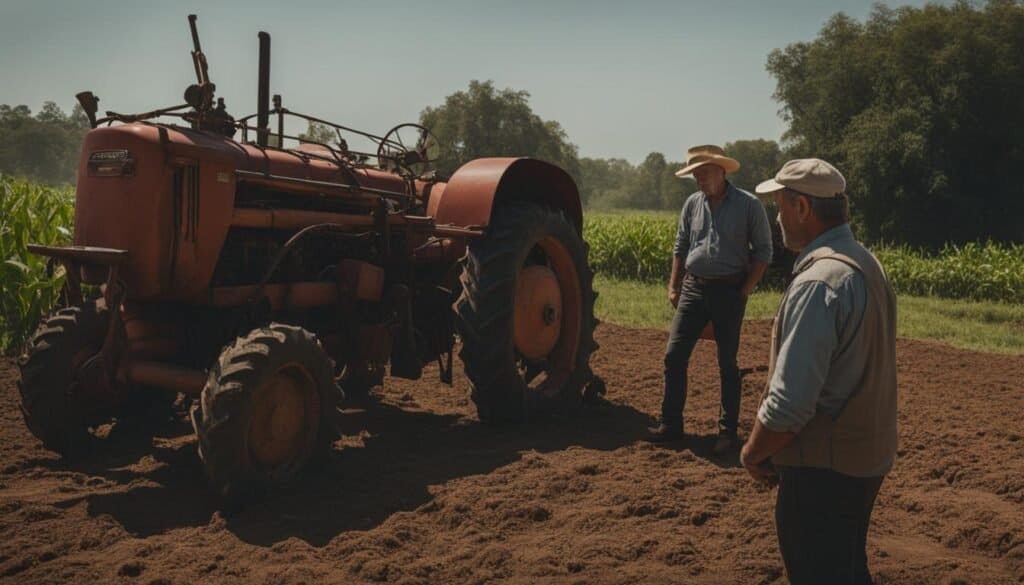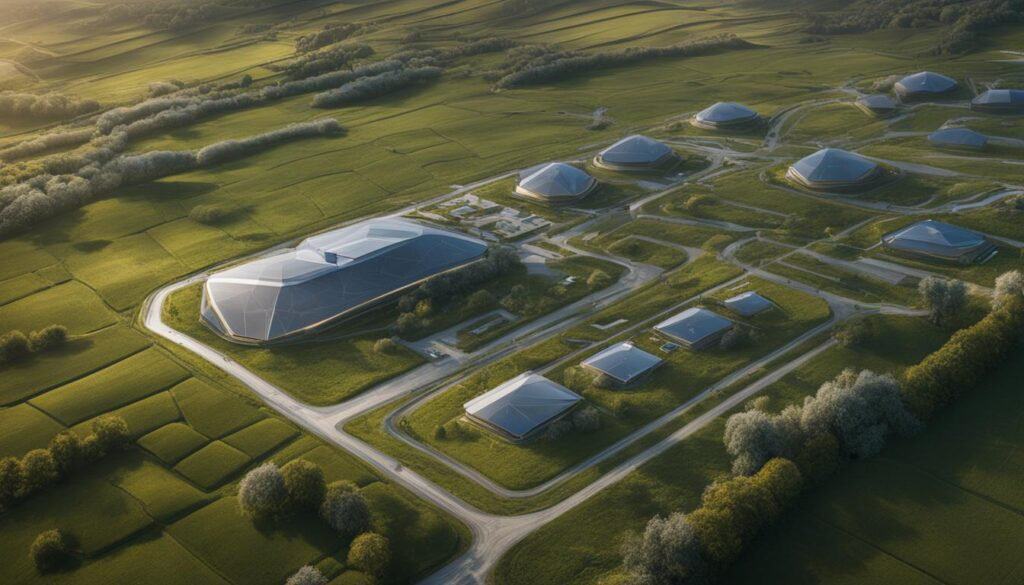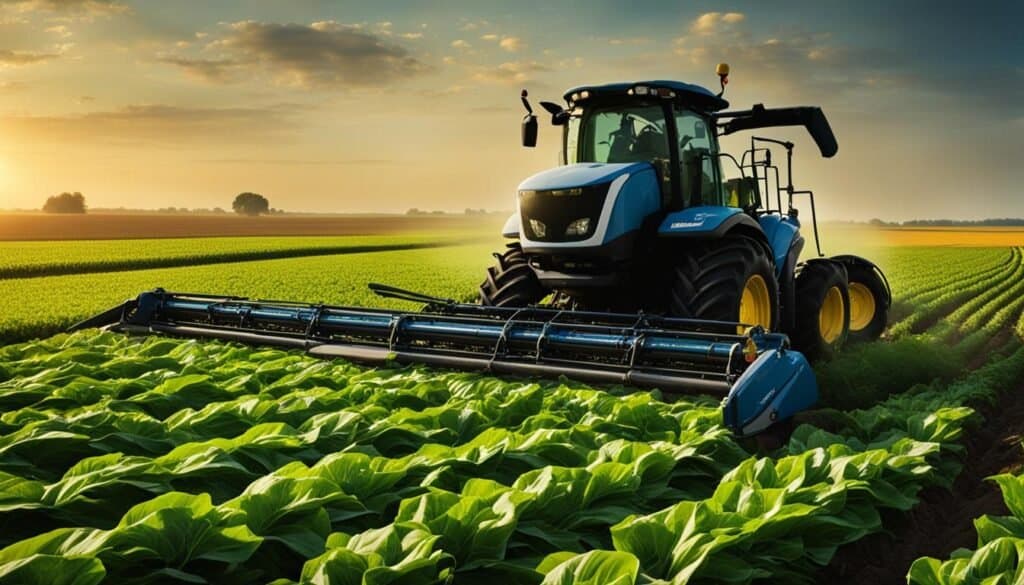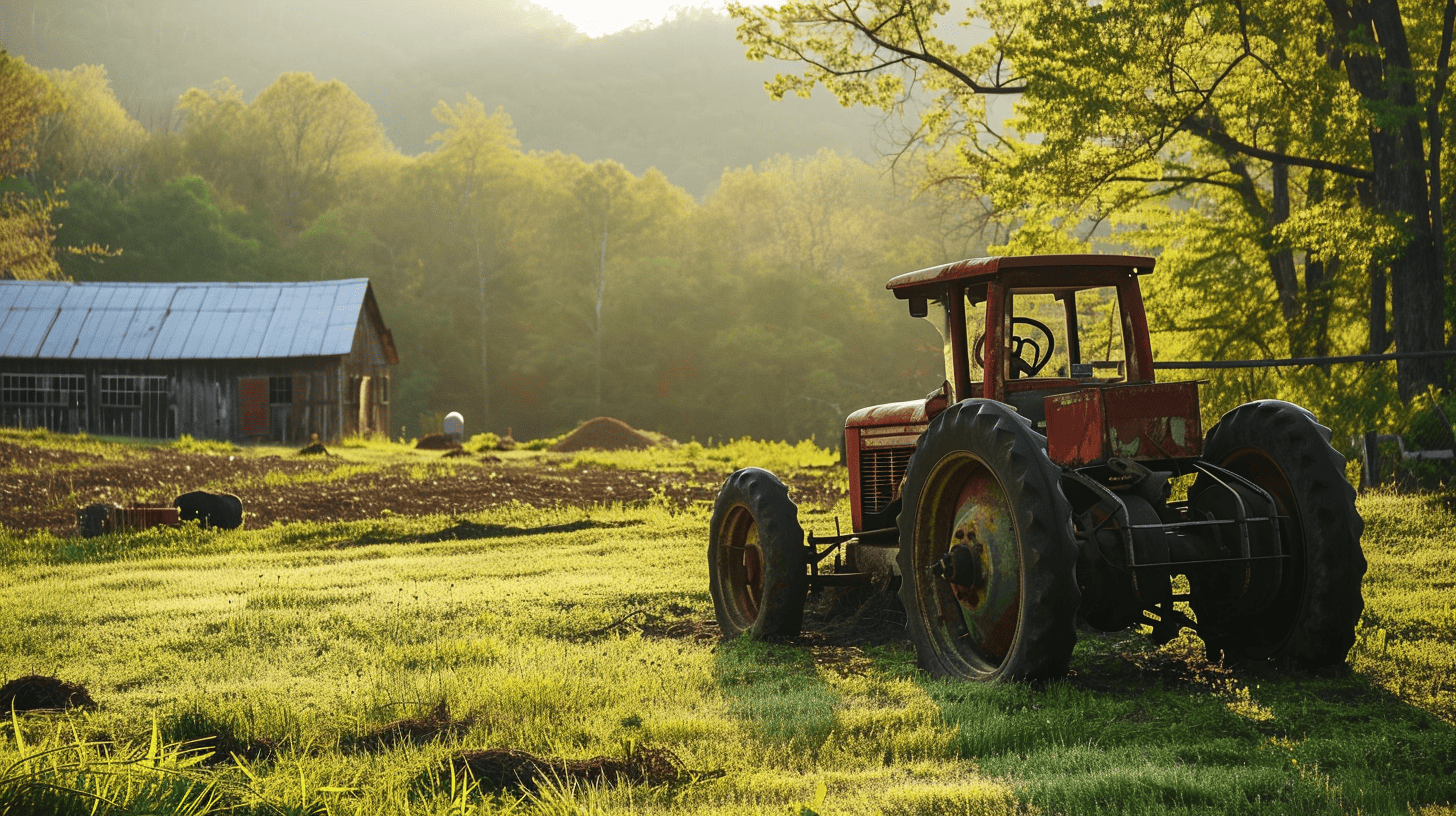I have seen how sustainable agricultural equipment production has the potential to transform the industry. By integrating cutting-edge technology into agricultural machinery, farmers can adopt more sustainable agricultural practices, reduce their environmental impact, and streamline their operations. Let’s dive into the exciting world of eco-friendly farming and explore the innovations that are shaping the future of agriculture.
Lets take a look at Sustainable agriculture equipment production in this article!
Key Takeaways:
- Advancements in agricultural machinery are helping farmers adopt more sustainable agricultural practices.
- Modern technology is reducing the environmental impact of agricultural operations.
- Eco-friendly farming is becoming more efficient and streamlined through innovation.
- AI, machine learning, drones, and precision farming are revolutionizing the industry.
- Challenges still remain in fully adopting these sustainable technologies, but their potential benefits are immense.
Embracing AI and Machine Learning for Smarter Farming
Emerging technology like AI and machine learning is revolutionizing agriculture by offering farmers innovative approaches to smart crop management and resource optimization. The following are some examples of how these technologies are transforming the landscape of agriculture to become more efficient, intelligent, and sustainable.
BASF discusses their commitment to bringing major R&D projects to market by 2030, focusing on innovations in seeds, traits, crop protection, and digital solutions that manage diseases, weeds, pests, and resources while reducing land use and applications.
Predictive Analytics for Resource Optimization
Predictive analytics are playing a pivotal role in agriculture by utilizing real-time data, machine learning models, and various algorithms to analyze factors such as weather, soil, and crop health. This technology enables farmers to predict crop yields with improved accuracy, allowing for better decision making and resource management that reduces waste and boosts agricultural efficiency.
“With the help of AI-powered predictive analytics, farmers can optimize water and nutrient usage, resulting in sustainable crop yield prediction and resource usage minimization.”
Automating Routine Tasks with Intelligent Systems
Intelligent systems, such as automated agriculture machinery and labor-saving technology, are changing how farmers approach their work. For example, the Naio Oz weeding unit uses machine learning to handle routine tasks like seeding and weed removal. These advancements save time, reduce labor costs, minimize human error, and ultimately lead to improved crop quality and yield.
- Automated irrigation systems maintain soil moisture at optimal levels.
- Drones monitor crop health and assess pest infestations for targeted interventions.
- Robotic harvesters streamline crop collection, reducing manpower requirements.
Improving Crop Yields Through Data-Driven Strategies
Data-driven agriculture empowers farmers to make informed decisions, leading to enhanced crop management and strategic farming. AI and machine learning can detect diseases and pest infestations early on, allowing farmers to intervene in a timely manner and improving crop yields by mitigating potential losses.
| Data-Driven Approaches | Benefits |
|---|---|
| Remote sensing technology | Monitors crop health to identify issues before they spread. |
| Soil nutrient analysis | Helps determine the optimal combination of fertilizers for each crop. |
| Weather forecasting | Allows farmers to adapt their strategies based on expected conditions, such as drought or heavy rainfall. |
Overall, embracing AI and machine learning for smarter farming practices not only helps improve crop yields but also promotes resource optimization and sustainable agriculture for the long term, addressing pressing global challenges such as climate change and food security.
The Rise of Drones in Precision Agriculture
As precision agriculture continues to evolve, drones have become an indispensable tool in sustainable crop management. These versatile flying devices are not just transforming the industry by enhancing crop health monitoring and resource allocation but also significantly reducing the environmental footprint of farming practices.
Drones in farming are exceptionally effective in capturing high-resolution aerial images of fields, providing invaluable data for effective crop management. Farmers can leverage these detailed aerial photos to identify any issues like soil variation, crop stress, and signs of pest infestations or diseases, leading to early disease detection and effective intervention.
“Drones allow us to closely monitor our fields in real-time, ensuring that we can detect issues at an early stage and implement targeted solutions to save resources while maintaining or even enhancing crop yields.”
Moreover, drones offer increased precision in applying fertilizers and pesticides, ensuring that these vital resources are delivered only to the areas that need them. As a result, farmers can minimize the environmental damage caused by excessive chemical runoff while also reducing overall costs.
- Reduced environmental impact through precise application of fertilizers and pesticides
- Lowered costs due to targeted resource allocation
- Improved water conservation through localized irrigation strategies
Aiding water conservation efforts in agriculture has become another crucial advantage of drones. By capturing detailed aerial images of soil moisture levels, these devices enable more effective water management. This results in the implementation of localized irrigation strategies, preventing excessive water waste and preserving valuable resources.
| Drone Applications in Agriculture | Benefits |
|---|---|
| High-resolution aerial imagery for crop health monitoring | Early detection of disease or pest infestations, enabling proactive intervention |
| Precise application of fertilizers and pesticides | Reduced environmental impact and lower resource costs |
| Assessment of soil moisture levels for irrigation management | Improved water conservation through targeted irrigation strategies |
In conclusion, the adoption of drones in precision agriculture has brought forth numerous benefits such as early disease detection and sustainable crop management. These advances enable farmers to optimize resources and minimize environmental damage while maintaining or even enhancing crop yields and overall sustainability in agriculture.
How GPS and Data Analytics are Refining Farm Management
Utilizing cutting-edge advancements like GPS mapping and agricultural data analytics have transformed traditional farm management into a more efficient and environmentally responsible practice. Precision agriculture techniques and resource efficiency strategies enable farmers to tackle issues such as spatial variability, making the most out of their resources and contributing to a sustainable future.
Mapping Out Efficiency: The GPS Revolution in Farm Machinery
GPS mapping plays a crucial role in precision agriculture, providing accurate field data to guide customized farming practices. By accounting for spatial variability, farmers can now make more efficient use of resources like water, seeds, and fertilizers, leading to reduced waste and lowered operational costs. Apart from this, the use of GPS technology in farm machinery also enables real-time field insights, making decision-making more timely and well-informed.
“The introduction of GPS mapping has ushered in a new era of resource efficiency and strategic farming, allowing farmers to optimize inputs and reduce waste while increasing productivity and profits.”
Turning Data into Decisions: Analytics for Crop Improvement
Combining remote sensing technologies with agricultural data analytics, farmers now have access to valuable insights into field conditions, weather patterns, and crop health. This wealth of information enables informed decisions on crop improvement strategies and predictive modeling solutions to tackle farming issues preemptively. Trend analysis and data-driven insights empower farmers to boost productivity and stay ahead of potential pitfalls in their operations.
The following table highlights some of the benefits achieved by fusing GPS mapping and data analytics into farm management:
| Aspect | Benefits of GPS and Data Analytics |
|---|---|
| Resource Efficiency | Optimization of water, seeds, and fertilizers for reduced waste and lower costs |
| Precision Agriculture | Accurate field mapping to minimize environmental impact and improve yields |
| Crop Improvement Strategies | Data-driven insights for informed decision-making and preemptive problem-solving |
| Trend Analysis | Real-time field monitoring for timely responses to emerging patterns and issues |
By harnessing the potentials of GPS mapping and data analytics in farm management, modern farmers are able to revolutionize the way agriculture is approached, aiming for a more sustainable and environmentally-friendly future.
Vertical Farming: A New Dimension in Urban Agriculture
As urban populations continue to grow, the need for sustainable and efficient food production becomes increasingly crucial. Vertical farming, an innovative solution, takes urban agriculture to new heights by utilizing stacked layers or skyscraper-like structures for crop production. This technique makes efficient use of space, conserves water, and provides an opportunity for local food production, all while reducing overall carbon emissions.
Two key methods in vertical farming systems are hydroponics and aeroponics, which allow for the cultivation of plants without soil. These methods, combined with controlled environment agriculture, enable precise management of resources, reducing water usage and chemical input.
Vertical farming not only revolutionizes urban agriculture but also offers significant environmental benefits, such as reduced water consumption, decreased chemical use, and lower carbon emissions.
One notable example of a successful vertical farm is Plenty, a San Francisco-based company that harnesses data analytics and machine learning to optimize crop growth. Plenty’s vertical farms use up to 95% less water than traditional farms while significantly reducing the need for pesticides, fungicides, and herbicides.
- Efficient space utilization: Vertical farms can be built within densely populated urban areas, making use of previously unused spaces such as building rooftops or abandoned warehouses.
- Year-round crop availability: Controlled environment agriculture enables vertical farms to produce crops throughout the year, regardless of weather conditions or seasonal changes.
- Reduced chemical use: Since vertical farms use hydroponics or aeroponics, which require fewer chemicals than conventional soil-based farming, they minimize environmental impacts from chemical runoff and pollution.
- Lower carbon emissions: Producing food locally reduces transportation-related carbon emissions, helping to mitigate climate change.
Overall, the integration of vertical farming into urban agriculture presents a sustainable and promising solution to address the growing demand for food in densely populated areas, while minimizing detrimental environmental impacts.
Overcoming Obstacles in Agri-Tech Adoption

As sustainable agricultural technology continues to evolve, it faces considerable challenges in rural areas due to infrastructure inadequacies and a lack of adequate internet connectivity. This digital divide hinders the agri-tech adoption process and impedes access to renewable energy solutions in more remote regions. Moreover, traditional farmers’ resistance to technological transition also arises from a lack of digital literacy and concerns over data privacy.
To tackle these challenges, a two-pronged approach involving infrastructure development and agri-tech educational initiatives is needed. This includes implementing farmer training programs designed to facilitate a smooth transition for those embracing digital transformation benefits in agriculture.
Perkins notes that reducing or eliminating soil tillage has become a priority, leading to the development of new equipment that supports minimum tillage and direct drilling practices.
Infrastructure Challenges and the Digital Divide in Rural Areas
The inadequate infrastructure in rural regions often results in limited internet connectivity, which directly contributes to the prevailing digital divide. Access to a reliable internet connection is crucial for leveraging advanced agricultural technology and ensuring seamless communication with stakeholders in the industry. Bridging this divide not only encourages agri-tech adoption but also paves the way for implementing renewable energy solutions in rural areas.
Government-backed projects and partnerships between public and private entities can be instrumental in enhancing rural infrastructure and providing much-needed connectivity to these regions. Developing the infrastructure will enable farmers to access cutting-edge agri-tech solutions that can transform their farming methods and ultimately contribute to a more sustainable and efficient agricultural sector.
Educational Initiatives to Support Technological Transition
Another critical aspect of overcoming the barriers to agri-tech adoption is the establishment of comprehensive agri-tech educational initiatives. These educational programs must focus on:
- Familiarizing farmers with the benefits of advanced agricultural technology
- Providing hands-on training with agri-tech tools and equipment
- Facilitating a better understanding of data privacy and security
By equipping farmers with the necessary knowledge and skills, these initiatives can help mitigate resistance to the technological transition in agriculture. Moreover, it fosters a culture of continuous learning and adaptation, enabling farmers to stay abreast of the latest developments in agri-tech and implement them for enhanced productivity and sustainability.
Investing in farmer training programs and infrastructure development is vital for harnessing the full potential of agri-tech adoption and promoting sustainable growth in the agricultural sector. With dedicated efforts to overcome these obstacles, the digital transformation benefits can be attained at scale, driving prosperity for rural communities and bolstering global food security.
Robotics and Automation: Changing the Landscape of Farm Labor
As the agriculture industry faces increasing pressure to support the global population and ensure food security, it is turning to agricultural robotics and automation as key solutions. This shift is not only enhancing the sector’s efficiency but also transforming the way farm labor operates. Utilizing AI-powered technology, autonomous cultivation, and state-of-the-art machines, farmers are discovering innovative ways to reduce labor costs and maintain high production standards.
One remarkable example of how automation in farming is revolutionizing the field is the implementation of autonomous vehicles. These machines are designed to navigate field terrain with ease, conducting tasks such as planting, fertilizing, and harvesting crops more efficiently than human workers. This extraordinary achievement not only addresses labor shortages but also paves the way for more sustainable farming practices by minimizing the scope for human error.
“Agricultural robotics have the potential to address key challenges in the agriculture industry, including labor shortages, rising costs, and sustainability.”
Another exciting development in the agricultural robotics space is the advent of drones. Previously seen as toys or photography equipment, these airborne devices are now taking farm management to new heights. Equipped with advanced sensors and imaging capabilities, drones can monitor crop health, detect pests and diseases, and provide invaluable input for farmers as they make informed decisions about their land.
- Optimizing pesticide and fertilizer application with aerial scouting
- Assessing soil health from a bird’s-eye view
- Presenting farmers with real-time data to inform decision-making
Besides autonomous vehicles and drones, various other agricultural robots are changing the game for farmers. These machines can carry out a vast array of tasks, such as cultivating plants with precision, managing pests, and streamlining harvesting processes. By closely examining market demand variables and factoring this information into their operations, farmers will optimize their harvests, contributing to an overall enhancement of agricultural profitability.
| Robot Type | Primary Function | Key Benefit |
|---|---|---|
| Autonomous Machines | Seeding, planting, and harvesting | Boost efficiency, save time and labor |
| Drones | Monitoring crop health, detecting pests | Enable proactive management of crop issues |
| Other Robots | Precise cultivation, pest management | Optimized harvests and enhanced profitability |
In conclusion, agricultural robotics and automation are poised to change the landscape of farm labor significantly. As the world continues to grapple with populations pressures, food demand, and environmental concerns, embracing these technological advancements will prove crucial for creating a resilient, efficient, and sustainable agricultural industry.
Integrating Big Data and IoT in Sustainable Farming Practices

The rapid advancements in big data in agriculture and the Internet of Things (IoT) in agriculture have led to a revolution in sustainable farming practices. By enhancing operational efficiency, optimizing resource inputs, and facilitating data-driven farming, these technologies pave the way for modernized and more sustainable agriculture.
Enhancing Operations with Data-Driven Insights
Big data in agriculture has been instrumental in transforming traditional crop and livestock management practices. By employing sensor technology and other recording tools, farmers can now access real-time data collection and make informed decisions. These decisions increase productivity and efficiency, ultimately leading to smarter and more sustainable farming practices.
“Big data in agriculture empowers farmers to make informed decisions by offering insights on soil health, crop growth, and yield predictions, thus driving sustainable farming practices.”
By integrating advanced analytics, machine learning, and artificial intelligence, big data provides invaluable insights, enabling farmers to optimize resource usage, reduce waste, and improve overall agricultural efficiency.
The Pivotal Role of IoT in Modernizing Agriculture
Internet of Things (IoT) devices have become an integral part of modern agriculture. IoT devices play a crucial role in collecting data about factors like soil moisture, temperature, crop health, and equipment performance. This vast pool of data is then translated into actionable recommendations for farmers, aiding them in their decision-making processes and ensuring higher profitability.
| IoT Applications in Agriculture | Benefits |
|---|---|
| Smart irrigation systems | Resource conservation and increased efficiency |
| Remote monitoring of livestock | Improved animal health and welfare |
| Precision farming equipment | Optimal resource allocation and waste reduction |
| Autonomous farm machinery | Labor cost reduction and increased productivity |
IoT technology’s wide-range applications and the real-time data it offers have resulted in a paradigm shift within the agriculture industry. By enabling farmers to make more informed decisions, the integration of IoT devices has led to sustainable, efficient, and smart agriculture practices.
As the adoption of big data and IoT in agriculture continues to grow, the industry can increasingly capitalize on operational enhancements and resource input optimization, ensuring long-lasting sustainability and food security for the future.
Financial Models and Investment Trends in Ag-Tech

As the adoption of agriculture technology becomes increasingly vital for sustainable farming, innovative financial models and investment trends are emerging to support these advancements. Compelling opportunities are arising as a result of the increasing demand for sustainable farming practices, alongside the growing costs of ag-tech implementation.
One of these financial models revolves around subscriptions and usage fees for agricultural robots and AI systems. This approach allows farmers to access advanced technology without being burdened by hefty upfront costs, making digitalization more feasible and appealing. Moreover, financing solutions from organizations like De Lage Landen (DLL) help further support the adoption of this modern technology.
- Corporate venture capital: Large agricultural companies are increasingly deploying corporate venture capital to invest in startups, staying ahead of the innovation curve and fostering technological advancements in the sector.
- Impact investing: Investments driven by social and environmental impact, alongside financial returns, are gaining momentum in the ag-tech sector. Impact investors prioritize investment opportunities in sustainable agriculture solutions that address environmental challenges, food security, and economic development.
- Public-private partnerships: Governments and private organizations have been collaborating to establish public-private partnerships, promoting the development and adoption of ag-tech innovations, such as AI, IoT, and big data analytics, to create sustainable food systems.
Investing in ag-tech not only benefits farmers and the environment but also results in a promising financial return. Digitized farms have demonstrated increased revenue growth compared to their non-digitized counterparts, indicating a bright future for investment in this space.
Amidst increasing technology costs, finance models like subscriptions and usage fees for robots and AI, along with financing solutions from organizations like DLL, make digitalization feasible for farmers, suggesting a bright investment future as digitized farms show increased revenue growth compared to their non-digitized counterparts.
Conclusion on Farm Equipment and Sustainability
As we have seen, the rapid integration of AI in agriculture and other innovative technologies has fundamentally changed the farming industry, setting it on a path towards a more efficient and sustainable farming future. These game-changing technologies, including drones, precision agriculture, and vertical farming, offer numerous benefits to both farmers and the environment, enabling sustainable agricultural practices that minimize waste and negative environmental impact.
Despite challenges, such as infrastructure limitations and reluctance from traditional farmers, the drive towards the adoption of cutting-edge agri-tech is undeniable. By embracing these transformative technologies, we can help address pressing global concerns like climate change and food security, ensuring a sustainable, innovative, and profitable future for the agriculture sector.
In conclusion, the marriage of time-honored farming practices with state-of-the-art technology is not only necessary but also crucial in ensuring that the industry adapts and thrives in harmony with the environment. The future of agriculture lies in the innovative adoption and integration of game-changing technologies, ultimately creating a more sustainable, profitable, and eco-friendly world.
FAQ on Sustainable Agriculture Equipment Production
Q: What is precision farming?
A: Precision farming, also known as precision agriculture, is a modern farming approach that utilizes technology such as GPS, GIS, and remote sensing for optimizing the efficiency and productivity of agricultural processes.
Q: How do sensors contribute to sustainable agriculture?
A: Sensors play a vital role in sustainable agriculture by monitoring and collecting data on factors like soil moisture, temperature, and nutrient levels, enabling farmers to optimize resource utilization and minimize environmental impact.
Q: What eco-friendly farming practices can be implemented in modern agriculture?
A: Eco-friendly farming practices in modern agriculture include using advanced equipment that minimizes energy consumption, reduces greenhouse gas emissions, and focuses on the development of sustainable solutions for a sustainable future.
Q: What are the benefits of using advanced irrigation technology in sustainable agriculture?
A: Advanced irrigation technology in sustainable agriculture leads to optimized water usage, reduced water wastage, and improved crop yield, contributing to sustainable development and future food security.
Q: How does sustainable agriculture equipment minimize environmental pollution?
A: Sustainable agriculture equipment minimizes environmental pollution by incorporating eco-friendly farming tools and techniques, reducing the use of harmful chemicals, and optimizing natural resources for farming activities.
Q: What role does mechanization play in revolutionizing sustainable agriculture equipment production?
A: Mechanization in sustainable agriculture production involves the use of advanced equipment and machinery for tasks such as tillage, crop protection, and fertilization, contributing to efficient and sustainable farming practices.
Q: How does sustainable agriculture contribute to future food security?
A: Sustainable agriculture contributes to future food security by emphasizing the development of eco-friendly farming technologies, sustainable solutions, and advanced equipment to meet the growing demand for food and agricultural products.
Q: What are the key features of eco-friendly sustainable solutions in modern agriculture?
A: Eco-friendly sustainable solutions in modern agriculture focus on utilizing energy-efficient equipment, minimizing environmental impact, and promoting sustainable development for a greener and more sustainable future.
Q: How does modern agriculture equipment support the optimization of natural resources?
A: Modern agriculture equipment supports the optimization of natural resources by integrating advanced technologies for monitoring and managing resources such as water, land, and energy, ensuring efficient and sustainable resource utilization.
Q: Why is the development of sustainable agriculture equipment crucial for the farming industry?
A: The development of sustainable agriculture equipment is crucial for the farming industry as it allows farmers to monitor and optimize farming processes, reduce environmental impact, and meet the increasing demand for food production while promoting sustainable and eco-friendly farming practices.





Leave a Reply